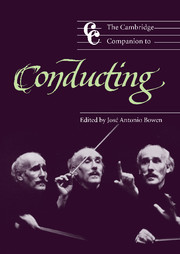14 - The Russian tradition
from Part II - History
Published online by Cambridge University Press: 28 September 2011
Summary
It was not until the mid-1930s that a Russian school of conducting began to reap what had been so carefully sown at the beginning of the century. In the constant swinging back and forth of the pendulum whereby Western conductors were welcome (in the late 1920s), then avoided (up to the dissolution of the Association of Proletarian Musicians in 1932), then welcome again, and finally shunned when Stalin turned his country upside down in 1937, there turned out to be more virtue than necessity in relying on homegrown talent. Since then, the line has been unbroken, and even at a time when the ranks of the old guard are rapidly diminishing, the tradition seems to have passed effortlessly to a whole new generation of younger conductors taking up positions with orchestras in the West.
Illustrious visitors: the nineteenth century
Russia in the nineteenth century was far too busy establishing and consolidating its musical institutions to breed that luxury, the great interpreter. In any case, the rival factions who so blurred the lines of real distinction in the 1860s, combined with the lack of any recorded evidence, make it difficult for us to establish any kind of objective truth. Was that leader of a truly national aesthetic, Mily Balakirev (1837–1910), a fine or a mediocre conductor when he took charge of the Russian Musical Society concerts?
- Type
- Chapter
- Information
- The Cambridge Companion to Conducting , pp. 191 - 202Publisher: Cambridge University PressPrint publication year: 2003

